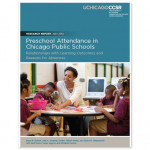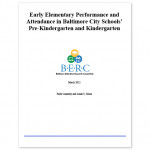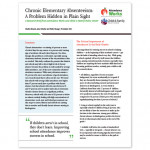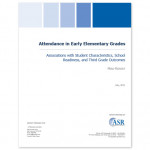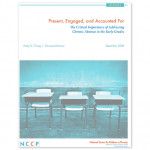Below is a list of seminal research related to attendance
For the full list of research and reports, please visit the All Research page.
Preschool Attendance in Chicago Public Schools: Relationships with Learning Outcomes and Reasons for Absences
Ehrlich, Stacy B. University of Chicago, Consortium on Chicago School Research, May 2014. This report highlights the critical importance of consistent preschool attendance. Students who attend preschool regularly are significantly more likely than chronically absent preschoolers to be ready for kindergarten and to attend school regularly in later grades, the report finds. The study, which follows 25,000 three- and four-year-olds…
The Importance of Being in School: A Report on Absenteeism in the Nation’s Public Schools
Balfanz, Robert and Vaughn Byrnes. Baltimore: Johns Hopkins University Center for Social Organization of Schools. May 2012. Researchers evaluated chronic absence data from six states—Georgia, Florida, Maryland, Nebraska, Oregon and Rhode Island—to assess trends and predict the size of the nation’s attendance challenge. A national rate of 10 percent chronic absenteeism seems conservative and it could be as high as…
Early Elementary Performance and Attendance in Baltimore City Schools’ Pre-Kindergarten and Kindergarten
Connolly, Faith and Linda S. Olson. Baltimore Education Research Consortium, Baltimore, Md., March 2012. This brief looks at attendance in the early grades with particular focus on Pre-Kindergarten (PreK) and Kindergarten (K) and follows these young students over time. The study finds that students with low attendance in both PreK and K often continue to have low attendance, are more…
Chronic Elementary Absenteeism: A Problem Hidden in Plain Sight
Bruner, Charles, Anne Discher, and Hedy Chang. Child and Family Policy Center and Attendance Works, November 2011. This study confirms the premise that districts and schools may fail to detect high levels of chronic absence because the problem is easily masked by average daily attendance, one of the most commonly calculated attendance measures. While many educators assume a 95 percent…
Longitudinal Attendance Patterns: Developing High School Dropouts
Schoeneberger, Jason A. The Clearing House: A Journal of Educational Strategies, Issues and Ideas, 85:1, 7-14. In this study, the researcher used longitudinal data on student attendance patterns from a large urban school district to model trajectories over time and categorize students into groups based on their attendance patterns from 1st through 8th grades. Using this technique, the study identified…
Attendance in Early Elementary Grades: Association with Student Characteristics, School Readiness and Third Grade Outcomes
Applied Survey Research, May 2011. A study commissioned by Attendance Works suggests that attendance in the early grades is critical to sustaining the school readiness skills that preschool or Head Start programs can help children to develop. This study conducted by Applied Survey Research examined the progress of 640 young California children in San Mateo and Santa Clara counties where…
Present, Engaged and Accounted For: The Critical Importance of Addressing Chronic Absence in the Early Grades
Chang, Hedy and Mariajose Romero. National Center for Children in Poverty, New York, NY, September 2008. This report documents the consequences, prevalence, potential causes and possible solutions to children missing extended periods of school in grades K-3rd. Although students must be present and engaged to learn, thousands of this country’s youngest students are academically at-risk because of extended absences when…
